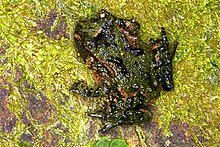Hochstetter's frog
| Hochstetter's frog | |
|---|---|
 |
|
| Scientific classification | |
| Kingdom: | Animalia |
| Phylum: | Chordata |
| Class: | Amphibia |
| Order: | Anura |
| Family: | Leiopelmatidae |
| Genus: | Leiopelma |
| Species: | L. hochstetteri |
| Binomial name | |
|
Leiopelma hochstetteri Fitzinger, 1861 |
|
 |
|
| Range (does not show Maungatautari) | |
Hochstetter's frog or Hochstetter's New Zealand frog (Leiopelma hochstetteri) is a primitive frog native to New Zealand, one of only four extant species belonging to the taxonomic family Leiopelmatidae. They possess some of the most ancient features of any extant frogs in the world.
Hochstetter's frog is named after the German geologist Ferdinand von Hochstetter. This species is endemic to New Zealand and belongs to the most primitive anuran suborder Archaeobatrachia, along with Archey's frog (Leiopelma archeyi), Hamilton's frog (L. hamiltoni), and the Maud Island frog (L. pakeka). Three species within the genus, L. auroraensis, L. markhami, and L. waitomoensis, are extinct.
Hochstetter's frog has a brown-green to brown-red top with dark bands and warts, yellow-brown bellies. Males grow to 38 mm (1.5 in) and females 50 mm (2.0 in) snout–vent length. They are nocturnal, staying under refugia during the day. Hochstetter’s frog prefers moist gaps under shaded debris, like rocks and logs and along streams and seepages in native temperate rainforest. They are carnivorous, preying on invertebrates such as spiders, beetles, and mites. All native New Zealand frogs (pepeketua in Maori) share tail-wagging muscles, inscriptional ribs, round pupils, and a lack of eardrums, eustachian tubes, and vocal sacs. These frogs, in some ways more similar to salamanders than modern frogs, use chemical signals over acoustic signals to mark habitat and recognize competitors. Hochstetter’s frogs poor hearing is complemented by their lack of vocalization.
Hochstetter's frogs can live to 30 years old. Adults do not breed until they are three years old, laying up to 20 eggs each season. While all four species develop as tadpoles inside the egg, hatching as froglets with developed back legs, Hochstetter’s frogs, as the only semiaquatic species, continue to develop in water while the three other species are cared for by their parents.
Subfossil remains indicate all native species were once widespread across New Zealand until roughly 200 years ago. Hochstetter's frogs have the most extensive distribution of the native frogs, spanning the upper North Island, including the Waitakere and Hunua Ranges, the Coromandel Peninsula, Great Barrier Island, Maungatautari Ecological Island, and the East Coast. Ten populations of this species have been found to be genetically distinct, owing to the history of glacial isolation.
...
Wikipedia

